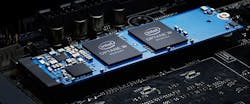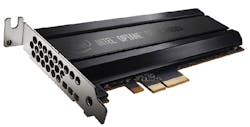Download the PDF of this article.
Intel’s Optane memory technology is finally available and it has possibilities when it comes to embedded platforms. In terms of performance, Optane sits between DRAM and flash memory. It has the non-volatility of flash memory but faster performance. The challenge for developers is that Optane’s price and capacity are higher and lower, respectively, compared to flash memory.
The 80-mm M.2 version is available in 16- and 32-Gbyte versions (Fig. 1). It targets consumer PCs as a cache for hard drives. The capacity is much lower than flash memory, which currently tops out at 2 Tbytes. Intel uses only two lanes of a possible four-lane NVMe interface.
1. Intel’s Optane M.2 is available in 16- and 32-Gbyte versions.
The specs for the M.2 module are impressive. It has a read latency of 9 µs while write latency is 30 µs. Sequential read and write throughput is 1,350 Mbytes/s and 290 Mbytes/s, respectively. Random read and write performance is 240,000 and 65,000 IOPS. Active power requirements are 3.5 W while it idles at 1 W. Another place where Optane shines is write endurance. The lifetime write endurance rating is 182.5 Tbytes. That’s more than 5,800 drive writes.
M.2 sockets are becoming more common on embedded motherboards. They’re actually the norm with new consumer and enterprise motherboards. M.2 sockets can also be found in PCI Express boards.
“Embedded designs, thanks to their custom application software, are probably more ready to use persistent memory than are more standard applications,” said Jim Handy, analyst at Objective Analysis, “and a lot of the pieces are already in place, since SNIA and the Linux community have hammered out programming standards to support it. But even if these designs don’t take advantage of Optane’s persistence, it’s still a good fit for a lot of applications since it’s faster than flash and cheaper than DRAM. This gives it the capability to reduce overall system costs while boosting performance, which is a ‘Win-Win’ for nearly any computing configuration.”
Embedded developers tend to have an advantage over consumer configurations as the performance requirements of an application are often known. This makes selection of memory technology, capacity, and performance easier. High capacity is not always a requirement for many embedded applications. This means that there will be some applications where Optane’s specs work better than flash memory. The application may work with Optane as the primary storage medium or as a cache.
Intel is targeting the enterprise with the PCI Express P4800X (Fig. 2). The larger form factor has a capacity of 375 Gbytes. It uses a x4 PCI Express interface. The P4800X has an endurance of 30 drive writes/day with a total endurance of 12.3 Petabytes.
2. The Optane P4800X PCI Express board targets the enterprise.
Some embedded applications may be able to take advantage of this form factor with the same considerations afforded to the M.2 module. It probably won’t be applicable for rugged applications given its specifications that are more amenable for enterprise server farms.
This is only the initial availability of Optane. Embedded designers tend not to jump on the bandwagon, but instead will wait to see how the technology develops.




